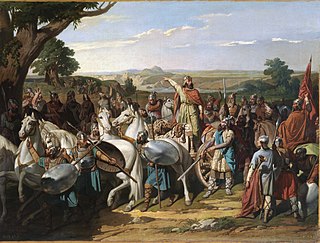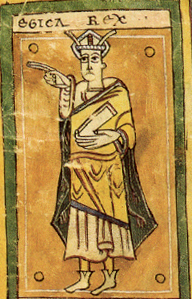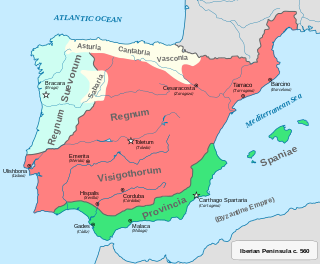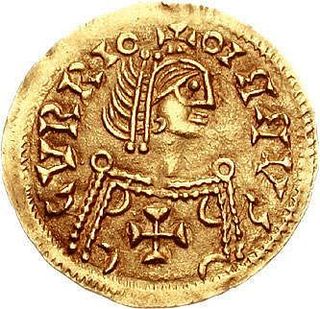Related Research Articles

The Reconquista or the reconquest of al-Andalus was the series of military campaigns that Christian kingdoms waged against the Muslim kingdoms following the Muslim conquest of the Iberian Peninsula by the Umayyad Caliphate. The beginning of the Reconquista is traditionally dated to the Battle of Covadonga, in which an Asturian army achieved the first Christian victory over the forces of the Umayyad Caliphate since the beginning of the military invasion. Its culmination came in 1492 with the fall of the Nasrid kingdom of Granada to the Catholic Monarchs.

Year 713 (DCCXIII) was a common year starting on Sunday of the Julian calendar, the 713th year of the Common Era (CE) and Anno Domini (AD) designations, the 713th year of the 1st millennium, the 13th year of the 8th century, and the 4th year of the 710s decade. The denomination 713 for this year has been used since the early medieval period, when the Anno Domini calendar era became the prevalent method in Europe for naming years.

Pelagius was a Hispano-Visigoth nobleman who founded the Kingdom of Asturias in 718. Pelagius is credited with initiating the Reconquista, the Christian reconquest of the Iberian Peninsula from the Moors, and establishing the Asturian monarchy, making him the forefather of all the future Iberian monarchies, including the Kings of Castile, the Kings of León, and the Kings of Portugal.

The Battle of Guadalete was the first major battle of the Umayyad conquest of Hispania, fought in 711 at an unidentified location in what is now southern Spain between the Christian Visigoths under their king, Roderic, and the invading forces of the Muslim Umayyad Caliphate, composed mainly of Berbers and some Arabs under the commander Ṭāriq ibn Ziyad. The battle was significant as the culmination of a series of Berber attacks and the beginning of the Umayyad conquest of Hispania. Roderic was killed in the battle, along with many members of the Visigothic nobility, opening the way for the capture of the Visigothic capital of Toledo.
Ṭāriq ibn Ziyād, also known simply as Tarik in English, was an Umayyad commander who initiated the Muslim conquest of Visigothic Hispania in 711–718 AD. He led an army and crossed the Strait of Gibraltar from the North African coast, consolidating his troops at what is today known as the Rock of Gibraltar. The name "Gibraltar" is the Spanish derivation of the Arabic name Jabal Ṭāriq, meaning "mountain of Ṭāriq", which is named after him.

Roderic was the Visigothic king in Hispania between 710 and 711. He is well-known as "the last king of the Goths". He is actually an extremely obscure figure about whom little can be said with certainty. He was the last Goth to rule from Toledo, but not the last Gothic king, a distinction which belongs to Ardo.

Orihuela is a city and municipality located at the feet of the Sierra de Orihuela mountains in the province of Alicante, Spain. The city of Orihuela had a population of 33,943 inhabitants at the beginning of 2013. The municipality has an area of 367.19 km2, and stretches all the way down to the Mediterranean coast, west of Torrevieja, and had a total population of 92,000 inhabitants at the beginning of 2013. This includes not only the city of Orihuela, but also the coastal tourist development hub of Dehesa de Campoamor with 33,277 inhabitants (2013) and a few other villages.

The Muslim conquest of the Iberian Peninsula by the Umayyad Caliphate occurred between approximately 710 and the 720s. The conquest resulted in the defeat of the Visigothic Kingdom and the establishment of the Umayyad Wilayah of Al-Andalus.
Achila II was the Visigothic king of Hispania from 710 or 711 until his death. The kingdom he ruled was restricted to the northeast of the old Hispanic kingdom on account of the Arabo-Berber invasions.

Wittiza was the Visigothic King of Hispania from 694 until his death, co-ruling with his father, Egica, until 702 or 703.

Egica, Ergica, or Egicca (c. 640 – 701/703), was the Visigoth King of Hispania and Septimania from 687 until his death. He was the son of Ariberga and the nephew of Wamba.
Ardo is attested as the last of all Visigothic kings of Hispania, reigning from 713 or 714 until his death in 720 or 721. The Visigothic Kingdom was already severely reduced in power and area at the time he succeeded Achila II, and his dominions probably did not extend beyond Septimania and present-day Catalonia, due to the Arab conquests of the previous three years.
Oppas, also spelled Oppa, was a member of the Visigothic elite in the city of Toledo on the eve of the Muslim conquest of Hispania. He was a son of Egica and therefore a brother or half-brother of Wittiza.
The Eighteenth Council of Toledo was the last of the councils of Toledo held in Visigothic Spain before the Moorish conquest of 711. It was held after the Seventeenth Council in 694, probably in 703 during the reign of King Wittiza (701–710) or his co-reign with his father, Ergica, from 693. It was presided over by Gunderic, Archbishop of Toledo.

Treaty of Orihuela was an early Dhimmi treaty imposed by the invading Umayyad Caliphate on the Christians in the city of Orihuela in the Iberian Peninsula in 713.

Spania was a province of the Eastern Roman Empire from 552 until 624 in the south of the Iberian Peninsula and the Balearic Islands. It was established by the Emperor Justinian I in an effort to restore the western provinces of the Empire.

The Visigothic Kingdom, Visigothic Spain or Kingdom of the Goths occupied what is now southwestern France and the Iberian Peninsula from the 5th to the 8th centuries. One of the Germanic successor states to the Western Roman Empire, it was originally created by the settlement of the Visigoths under King Wallia in the province of Gallia Aquitania in southwest Gaul by the Roman government and then extended by conquest over all of Hispania. The Kingdom maintained independence from the Eastern Roman or Byzantine Empire, whose attempts to re-establish Roman authority in Hispania were only partially successful and short-lived.

The history of Alicante spans thousands of years. Alicante has been regarded as a strategic military location on the Mediterranean coast of Spain since ancient times. It is protected on the southwest by Cape Santa Pola and on the southeast by Cape Huerta. The fortified complex of Santa Bárbara Castle, the older parts of which were built in the 9th century, dominates the city from a height of 160 m atop Mount Benacantil, a rocky massif overlooking the sea.
Julian, Count of Ceuta (Spanish: Don Julián, Conde de Ceuta,, Arabic: يليان, was, according to some sources, a renegade governor, possibly a former comes in Byzantine service in Ceuta and Tangiers who subsequently submitted to the king of Visigothic Spain before secretly allying with the Muslims. According to Arab chroniclers, Julian had an important role in the Umayyad conquest of Hispania, a key event in the history of Islam, and in the subsequent history of what were to become Spain and Portugal.
The Chronicle of 741 is a Latin-language history in 43 sections or paragraphs, many of which are quite short, which was composed in about the years 741-743 in al-Andalus. It is the earliest known Christian work produced under Muslim rule in Iberia.
References
- Collins, Roger (1989). The Arab Conquest of Spain, 710–797. Oxford: Oxford University Press. ISBN 0-631-15923-1.
- Collins, Roger (2003). E. Michael Gerli (ed.). Medieval Iberia: An Encyclopedia. London: Routledge.
- Collins, Roger (2004). Visigothic Spain, 409–711. Oxford: Blackwell Publishing. ISBN 0-631-18185-7.
- König, Daniel G. 2020. “713: The Treaty of Tudmir As a Testimony to the Muslim Subjection of the Iberian Peninsula”. Transmediterranean History 2 (1). https://doi.org/10.18148/tmh/2020.2.1.24.